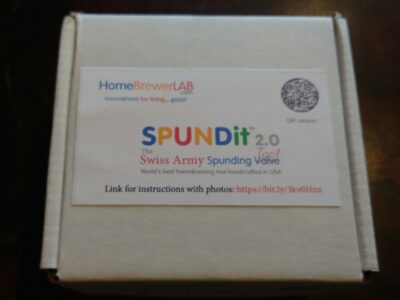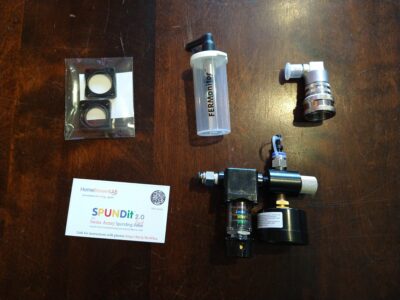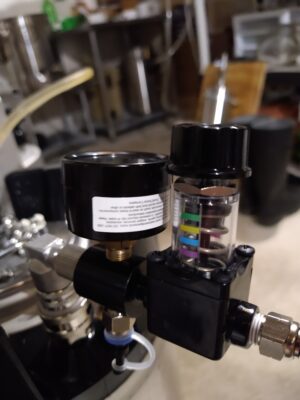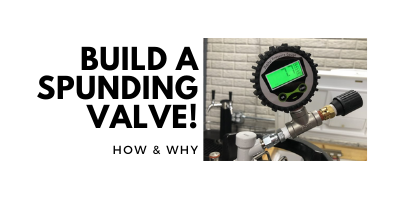
Hands on Review: SPUNDit Spunding Valve
This review is by Homebrew Finds Contributor Brad Probert. Brad is an engineer, expert homebrewer and experienced reviewer. Grab a link to Brad’s website at the end of this review.
Why a Spunding Valve?
There are loads of homebrew related applications for a Spunding valve ranging from pressurized ferementation to naturally carbonating to fixing over carbonated beers and lots more. Check out our resource post on the subject. It’s arguably the go-to resource on the Internet on the subject
SPUNDit 2.0 Spunding Valve
Spunding valves are probably one of the most boring pieces of homebrew kit. They perform a very simple function of mechanically regulating air/gas pressure. They can be used in various ways around the home brewery to do some cool stuff when it comes to fermentation, or when dealing with kegging. The SPUNDit does all the work of a regular spunding valve but does it in a swanky package.
Check Current Price & Availability, Review Continues Below:
SPUNDit 2.0 Spunding Valve – via eBay
There are two parts to any spunding valve- an adjustment knob connected to a mechanical valve, and a pressure gauge that measures the pressure it’s regulating. The SPUNDit is a diaphragm valve type of spunding, which has better operation than a poppet type. The diaphragm valve has a larger surface area for the regulation pressure to act upon and has better pressure regulation control because its opening & closing pressures have less hysteresis. The SPUNDit has a long travel spring and fine pitch thread on the adjustment knob, allowing you to make very minute changes in the regulation pressure.
Related: Fermenting Under Pressure!
The SPUNDit also adds some flair to the act of turning the knob to adjust pressure. The SPUNDit has a clear chamber where you can see the regulation spring, and the adjustable reaction plate that creates the pressure adjustment. As you turn the adjustment knob, you see the reaction plate move up or down within the clear tube, giving you a visual indication of your pressure adjustment before your fermentor ever builds up pressure. It has colored paint markings on the tube, showing approximately where the reaction plate needs to be positioned to give you 5, 10, 15, and 20 psi. Of course, there is a pressure gauge which tells you exactly what your regulation pressure is, but the markings help you set the spunding to the right regulation point before fermentation starts.
The pressure gauge has markings for both 0 – 30 psi, as well as 0 – 2 bar. The excess pressure is bled out through a tube attached to a Push To Connect fitting which runs into a clear container. You fill this container with sterile water and it becomes a bubbler, which they call a Fermonitor. As pressure exceeds your spunding set point, the CO2 pushes out through the tube and then causes a visual bubble stream. The more active your fermentation, the more rapid the excess CO2 pushes bubbles out through the Fermonitor. The other feature the SPUNDit has is an auxiliary pressure input port. It’s a 6mm OD PTC fitting, and with it you can hook up another fermentor and regulate its pressure at the same time. The last bit of bling on the SPUNDit is its hefty stainless steel ball lock disconnect. Aside from its shiny appearance, it provides durability & reliability for multiple connections on & off a lot of kegs and fermentors.
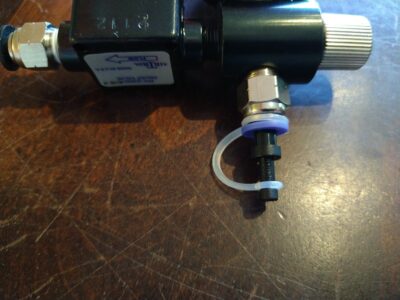 Auxilliary Input Pressure Port
Auxilliary Input Pressure Port
Hands on Review
The fit and finish of the SPUNDit was top-notch. High quality materials seemed to be used for all the parts, and they all fit together well for an overall high-quality piece of gear. There are of course many uses of a spunding valve. I didn’t have any over-carbed kegs to bleed down, but I did use it to provide backpressure in empty kegs while transferring carbonated beer into them (keeps beef from foaming up), and on a couple batches of beer I was fermenting under pressure. I used it while fermenting and holding different pressure levels at 2 psi, 15 psi, and 30 psi- a wide variety of usages.
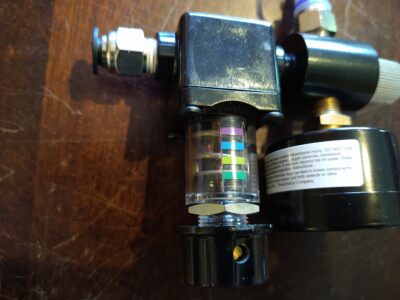 Color Markings on Adjustment Tube
Color Markings on Adjustment Tube
The operation was just as smooth as its looks. One unique thing about how the SPUNDit worked was the combination of the Fermonitor and the painted marks on the adjusting spring. While fermenting under pressure, I started off the first 24 hours with no spunding pressure, to get the yeast off to a healthy start. Then, depending on the beer, I would either set it to 2 psi (fermenting an ale), or 15 psi (fermenting a lager warm). With the paint markings, I could adjust the knob to set the spunding to where it needed to be once fermentation CO2 had built up. I could then go on about my business and not worry about being well under or over my desired pressure. I went back later and then fine-tuned the pressure based on looking at the vigor of the bubbles in the Fermonitor.
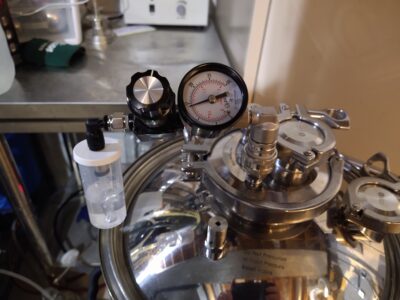 Fermenting Under Pressure at 15 psi
Fermenting Under Pressure at 15 psi
I noticed that the pressure adjustment fidelity was very good. I could make small pressure changes easily because small rotation of the adjustment knob made very small changes in pressure. This was compared to my other spunding valve, which used a shorter spring and was very sensitive to adjustments. To quantify this, I did some tests with a pressurized keg and saw how many rotations of the knob equated to a 5 psi change in spunding pressure. The SPUNDit went 3 complete rotations to adjust 5 psi, as compared to my other spunding valve which changed 5 psi with only 1/2 of a rotation of the adjustment knob. That was a huge difference.
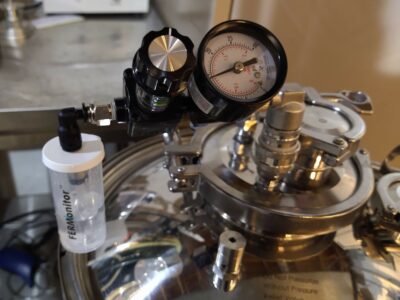 SPUNDit 2.0 Spunding Valve on BrewBuilt X1 Conical – Hands on Review
SPUNDit 2.0 Spunding Valve on BrewBuilt X1 Conical – Hands on Review
Conclusions
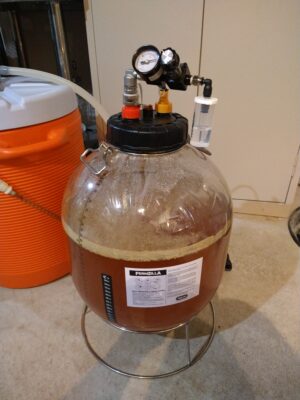 SPUNDit Set to 30 psi, Waiting to Build Pressure in FermZilla All-Rounder – Hands on Review
SPUNDit Set to 30 psi, Waiting to Build Pressure in FermZilla All-Rounder – Hands on Review
Before I actually got hold of a spunding valve and used it, I was intimidated by the concept. It seemed strange and complicated and a bit mysterious as to what made a good vs bad one. For me, the SPUNDit checked a lot of boxes- 30 psi capability, very fine pressure adjustment, and high-quality build. It was a bonus that it came in such an appealing design, with handy features like the color markings to guide your pressure adjustments, and small visual bubbler container to monitor fermentation progress. That said, everyone must choose how they part with their money, and there are cheaper options available in the market that also perform the function of spunding. So, whether the SPUNDit is worth it, is ultimately up to the buyer
Check Current Price & Availability, Review Continues Below:
SPUNDit 2.0 Spunding Valve – via eBay
Our Spunding Valve Resource Post!
tsrspundMore Photos
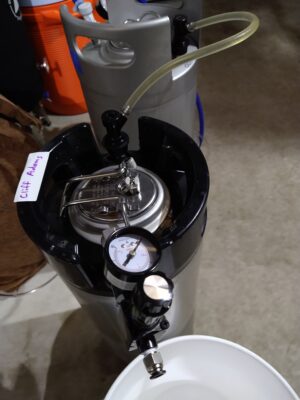 Providing Back Pressure While Transferring Beer into Keg
Providing Back Pressure While Transferring Beer into Keg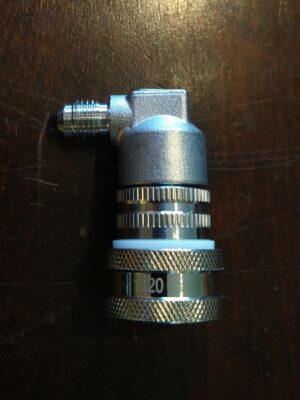 Stainless Ball Lock Disconnect
Stainless Ball Lock Disconnect
More Homebrew Finds!
- Last 50 Finds!
- Top Deals – a curated list of the best deals
- Homebrew Reviews – one of the largest libraries of homebrew reviews in existence!
- Our Top Posts – tips, how-tos, resources posts and more
Most Recent Deals
Fermenter Reviews!
We Are Homebrew Review HQ! Our 10 Most Recent Reviews
More Fermentation Related!
pinned
This post may contain affiliate links. We may make a commission when you use our links. This will never cost you extra. Thank you for supporting Homebrew Finds!
greatdealsBy Brad Probert. Check out Brad’s website – beersnobby.com
This is a Top Post! See: All Top Posts
Price, promotions and availability can change quickly. Check the product page for current price, description and availability.
Make sure the components you use are compatible and rated for your intended application. Contact manufacturer with questions about suitability or a specific application. Always read and follow manufacturer directions revew:spundit tag:tpr
